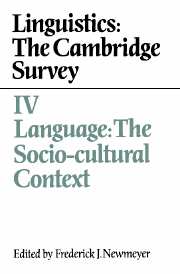Book contents
- Frontmatter
- Contents
- Contributors
- Preface
- 1 The study of language in its socio-cultural context
- 2 Language, culture, and world-view
- 3 Language and social class
- 4 Language and race: some implications for linguistic science
- 5 Language and gender
- 6 Bilingualism
- 7 Dialectology
- 8 Sociolinguistics and syntactic variation
- 9 Language birth: the processes of pidginization and creolization
- 10 Language death
- 11 Language planning: the view from linguistics
- 12 Ethnography of speaking: toward a linguistics of the praxis
- 13 The organization of discourse
- 14 Conversation analysis
- Index of names
- Index of subjects
- Contents of Volumes I, II, and III
6 - Bilingualism
Published online by Cambridge University Press: 05 June 2012
- Frontmatter
- Contents
- Contributors
- Preface
- 1 The study of language in its socio-cultural context
- 2 Language, culture, and world-view
- 3 Language and social class
- 4 Language and race: some implications for linguistic science
- 5 Language and gender
- 6 Bilingualism
- 7 Dialectology
- 8 Sociolinguistics and syntactic variation
- 9 Language birth: the processes of pidginization and creolization
- 10 Language death
- 11 Language planning: the view from linguistics
- 12 Ethnography of speaking: toward a linguistics of the praxis
- 13 The organization of discourse
- 14 Conversation analysis
- Index of names
- Index of subjects
- Contents of Volumes I, II, and III
Summary
Introduction
The topic of bilingualism (a term that generally includes multilingualism; cf. Weinreich 1953: 1) fits appropriately under many headings in a taxonomy of linguistic fields such as the one that forms the basis for this Survey. That people can and do know and use more than one language sets interesting and critical challenges to numerous subfields of the language sciences. One could therefore expect to find it treated in chapters dealing with neurolinguistics (are bilingual brains different?), with language processing (when a person is bilingual, are the two languages stored and processed separately?), with second language learning (by definition the study of how some people become bilingual), with pidgin studies (for speakers of pidgins are bilingual), with language death (as bilinguals give up on the use of one language in favor of another), and with language and education (for the usual aim of language education is to add control of one or more extra varieties of language).
The importance of the topic also means that there is a vast literature to review. Anyone seeking such an overview might safely start with any one of a number of reviews of the field: those which shaped its study, such as Weinreich 1953 or Haugen 1956, or which have charted its progress since then, such as Haugen 1973, Mackey 1976, Spolsky 1976 or, most recently, Grosjean 1982.
- Type
- Chapter
- Information
- Linguistics: The Cambridge Survey , pp. 100 - 118Publisher: Cambridge University PressPrint publication year: 1988
- 5
- Cited by



